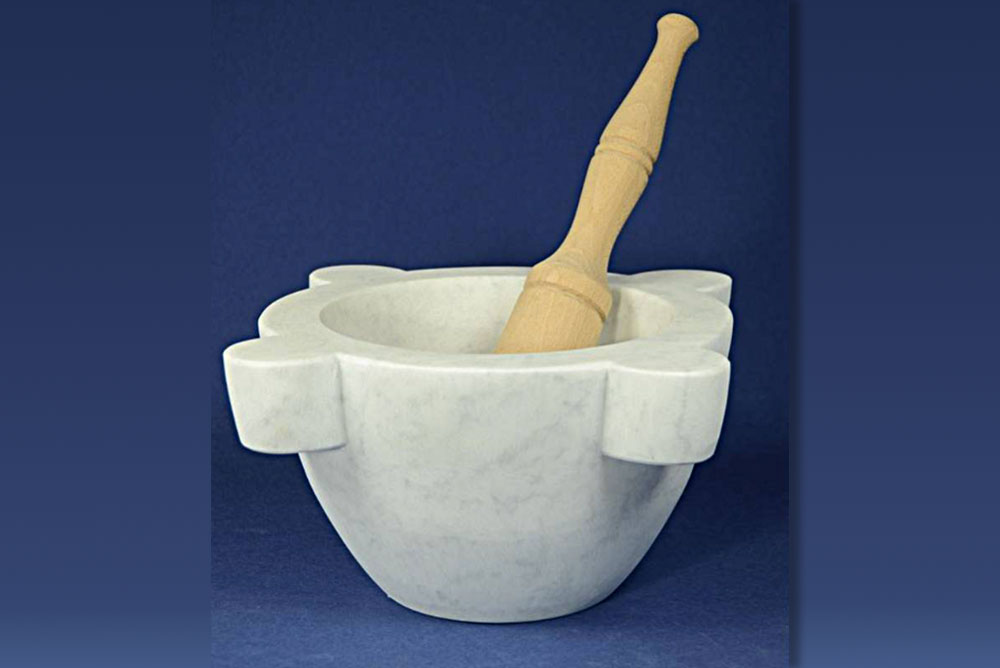
Above, a mortar made from Carrara marble. The mortar is in the traditional Genovese style, with four “ears.” The pestle is beechwood. / Photo here and on the front, courtesy of Nuova Marmotecnica.
By Nancy Pollard
 After owning one of the best cooking stores in the US for 47 years—La Cuisine: the Cook’s Resource, in Alexandria, Virginia—Nancy Pollard writes Kitchen Detail, a blog about food in all its aspects—recipes, film, books, travel, superior sources and food-related issues.
After owning one of the best cooking stores in the US for 47 years—La Cuisine: the Cook’s Resource, in Alexandria, Virginia—Nancy Pollard writes Kitchen Detail, a blog about food in all its aspects—recipes, film, books, travel, superior sources and food-related issues.
ANY TOURIST will tell you that Italy offers innumerable awe-inspiring revelations. It could be the Pietà, it could be pizza. The Bernini sculptures at the Villa Borghese in Rome, or maybe the arrosticini in the mountains of Abruzzo. For my husband, it was Paestum; for me it was pesto. Not just any pesto, but the genuine article ground out in an Italian mortar and pestle.
I have made pesto in a blender since I was first introduced to it by a neighbor. And I thought it was wonderful. Maybe it wasn’t ethereal, but it was certainly delicious and easy (not counting the time a spoon got stuck in the blades while the motor was running, and pesto landed on the ceiling). But my husband thought pesto tasted bitter and wore a martyred look when I made it. It was not until I went on product-hunting expeditions in Italy that I experienced what pesto should really taste like. The pesto was a little chunky, but light, aromatic beyond belief and with a flavor that was delightfully fresh without a trace of bitterness.
The Real Thing: Italian Mortar and Pestle

The lion’s-head ears of Nancy Pollard’s mortar, above, were hand carved by Giordano Baudoni, head of the family firm, Nuova Marmotecnica. / Photo by Nancy Pollard.
For this miracle to occur, we’re not talking about using a teensy mortar with a cute little matching pestle, nice for grinding some salt with garlic and rosemary. Real pesto calls for a rather substantial white marble mortar with a serious wood pestle. We used to import them at La Cuisine from the prized Baudoni family firm, Nuova Marmotecnica in Carrara, Italy. The firm was founded by Giordano Baudoni in 1969 and is still run by him and his son Cristiano. When you visit their website, you’ll see that they specialize in mortars, rolling pins, and meat pounders but offer other beautiful marble decorative pieces as well. I have one mortar with lions-head handles carved by Giordano Baudoni himself.
Unlike many other Italian mortars and pestles marketed to us, the ones from Nuova Marmotecnica are made from Carrara marble and created in Carrara itself. White Carrara marble, rather than a darker stone, makes it much easier to see the ingredients you are grinding but, more important, the stone is denser and absorbs less than other materials. If you put a glass of water in it, the next day the water will still be there. With other materials, as much as half the amount of water will be absorbed in 24 hours. In some cases, mortars are finished with an unknown substance to make them look polished, which is never done in the Baudoni workshop. The distinctive form of the Genovese shape, with its four “ears,” goes back centuries. Apparently, before machine tooling was introduced, the final exam for testing a marble worker’s ability was carving a mortar in this shape.

The mortar and pestle offerings from Nuova Marmotecnica, in the Massa-Carrara province of Italy. / Photo courtesy of the company.
Such a mortar and pestle will serve you well for a lifetime, then go on to serve generations to come. No software updates are necessary, there is no service expiration date, and it takes only a small amount of elbow grease. Judging by the number of gyms that have proliferated across the US, this should not be a problem. For pesto and similar sauces, I think you need one that is 20cm (8 inches) in diameter; I also use a 14cm (5½ inches) for smaller tasks.
The Nuova Marmotecnica website offers shipping to the US. This is a kitchen tool worth the investment for both its function and its beauty. Get a smaller one too and use it for grinding small amounts of spices or making a quick paste for a marinade. Having used mortars with wood and those with ceramic or stone pestles, I have found it easier to “humor the work” with a wood one.
The Holy Grail
 There are only seven ingredients in this magical sauce—no water, no cream—only garlic, pine nuts, Parmesan and Pecorino cheeses, salt, olive oil, and basil. The basil leaves should be small and fragrant and not large and leathery. If you grow basil, they are best picked before the plant starts growing its spiky flowers. I have made pesto with the large and leathery ones, and they will not break down into a paste the way the smaller ones do. Even though there are videos showing people using an up-down crushing or pounding motion, it is more effective to drive your pestle in a left to right circular motion consistently. This process really squeezes the leaves rather than cuts them, and your sauce will have more of that heavenly essential oil that is released from the veins of the basil leaves. I have found that the marble mortar is cold enough so that the process does not heat the leaves and it does not take too much time to reduce these seven sacred ingredients into the pesto of your dreams. Add it to the pasta of your choice. If you want to save it, cover it with a slick of olive oil and wrap it tightly with cling wrap in the fridge. There will be some discoloration but the taste remains sublime.
There are only seven ingredients in this magical sauce—no water, no cream—only garlic, pine nuts, Parmesan and Pecorino cheeses, salt, olive oil, and basil. The basil leaves should be small and fragrant and not large and leathery. If you grow basil, they are best picked before the plant starts growing its spiky flowers. I have made pesto with the large and leathery ones, and they will not break down into a paste the way the smaller ones do. Even though there are videos showing people using an up-down crushing or pounding motion, it is more effective to drive your pestle in a left to right circular motion consistently. This process really squeezes the leaves rather than cuts them, and your sauce will have more of that heavenly essential oil that is released from the veins of the basil leaves. I have found that the marble mortar is cold enough so that the process does not heat the leaves and it does not take too much time to reduce these seven sacred ingredients into the pesto of your dreams. Add it to the pasta of your choice. If you want to save it, cover it with a slick of olive oil and wrap it tightly with cling wrap in the fridge. There will be some discoloration but the taste remains sublime.
Remember cookbook author Anna Del Conte’s adage: Dress your pasta with sauce, not your sauce with pasta!
Pesto Genovese (as it should be)

- 2 peeled garlic cloves
- Small handful of coarse salt
- 2 tablespoons of Italian or Spanish pine nuts (not Chinese)
- 1¾ ounces (50gr) young, fresh basil leaves, rinsed in cold water and gently dried
- 2.3-ounces (45gr) of (45gr) grated Parmigiano Reggiano cheese, at least aged 2 years if possible
- ½ ounce (15gr) grated Pecorino Sardo cheese (the Sardinian sheep’s-milk cheese is creamier and less salty than Roman-style Pecorino
- 5 tablespoons of a light Extra Virgin Olive oil (obviously Ligurian is the home-town favorite)
- Start by crushing the garlic with a small amount of coarse salt until you have a paste.
- When you have creamed the garlic and salt together, add the pine nuts and continue to crush them, using the pestle in a circular motion until they have been creamed into the other two ingredients.
- Start adding the basil leaves, a few at a time, always moving your pestle in a circular motion, moving them along the interior wall of the mortar. Add more leaves as the first ones get crushed into the paste.
- Taste as you continue to add leaves, adding salt, which actually helps maintain the color.
- Add your grated cheeses. You do not have to add all of the grated cheese: You can add more when you create the final dish.
- Now add the oil until you achieve the consistency you want for your recipe.
- You can use Grana Padano if you can’t find decent Parmigiano.
- This recipe will adequately sauce 1 pound (494gr) of pasta if you are Italian, less so if you are American!

I made pesto from my basil last summer and froze it in small jelly jars. It was delish this summer. I freeze it with the cheese mixed in.
I love making pesto by hand. Also aioli. I wish I were young enough to invest for a lifetime in one of those lovely mortar and pestle sets. Instead, I invested in a large, deep molcajete. I get good results; I also find that freezing leftovers works great and keeps me in pesto all year.
This sounds delicious! But I think I will wait until fall as not much cooking done in this heat. Will save the recipe!